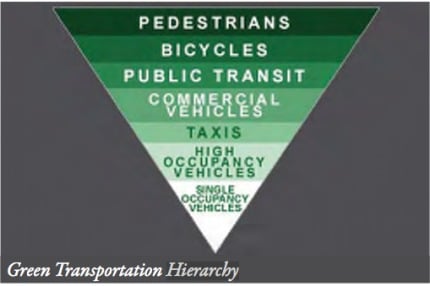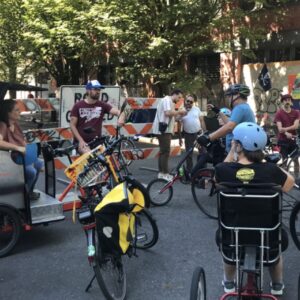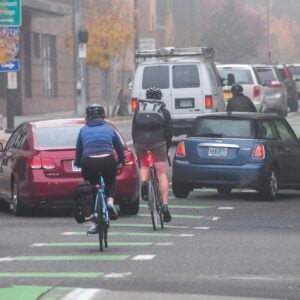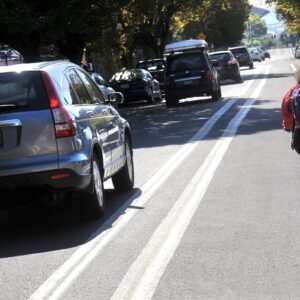[Publisher’s note: As we shared on May 16th, PBOT has unveiled plans for the Multnomah Street Main Street Pilot Project. The road this project has taken to this point has raised many concerned eyebrows. One of them is Craig Harlow. Harlow was chair of the stakeholder advisory committee for the NE Holladay Street project (which is — whether PBOT wants us to remember or not — closely tied to the Multnomah project) and he sat on the “task force” for the NE Multnomah project. Below, I’ve shared a letter from Harlow to PBOT project manager Ross Swanson – JM]
Dear Mr. Swanson:
“I am gravely concerned about the priorities of the Multnomah project.”
— Craig Harlow, member of project task force and former chair of Holladay Street project advisory committee
I primarily represent the interests of others like myself, parents who travel by bicycle with their kids in, through, and around the Lloyd District. I live in the Irvington neighborhood just 1 mile north of the Lloyd District, and commute to work by bike daily to my job in the Lloyd District. My sons walk and bike to meet me at work each day after school. I ride through the Lloyd District very often with all four of my kids, ages 4 through 17, on our way to downtown, the waterfront, and to SE Portland.
Today when I ride with my kids through the Lloyd District, we stick to the sidewalks exclusively, due to the lack of safe and comfortable facilities for families on bikes.
I was and am hopeful that this project on Multnomah will improve conditions for my family when we travel into the Lloyd District in the future.
I was a member of the task force that met this winter and spring to form the Lloyd TMA Board’s recommendation to the city for a road diet on NE Multnomah. I was previously the chair of the stakeholder advisory committee that oversaw the process for developing a plan to introduce a new bikeway on NE Holladay, which from its outset was repeatedly sabotaged by representatives of major Lloyd District property holder Ashforth-Pacific (now Langley), and was in its final hour effectively sunk by a single “nay” vote from Ashforth with support from the TMA, in what was otherwise a 12-to-1 vote in favor of implementing the Holladay project. That project was set aside by PBOT in order to pursue this project on Multnomah.
I am gravely concerned about the priorities of the Multnomah project. Priority #1 seems to be to reintroduce on-street parking along Multnomah, whether or not conditions improve for people on bikes, on foot, or on transit. Why is added parking the first priority and a non-negotiable component of this proposal, in a neighborhood already literally paved over by massive parking density?
PBOT’s participation in the Multnomah task force was accompanied by promise of a “truly world class bikeway”. A road diet and the associated traffic calming can be achieved without the addition of on-street parking. Why isn’t this being considered?
How is the Green Transportation Hierarchy (which appears on page 21 of the City Council adopted Bike Plan for 2030) being addressed by this PBOT project? Or rather, why is it not being considered?

I am deeply concerned that this project is being used by property holders to misdirect the public’s attention from the outcome of the Holladay project’s S.A.C. process, which was 1 vote shy (Ashforth) of unanimous approval for transforming NE Holladay into a new east-west bikeway through the Lloyd District. What is the fate of that project today?
I am also concerned because I see conditions for people on bikes worsening as an outcome of this proposal, rather than improving, on at least two counts:
(1) This proposal introduces a hazard that doesn’t exist today on Multnomah: the door zone. Whether parking is to the left or to the right of the bike lane, wherever there is on-street parking bikes will be in the door zone unless an adequate three-foot or four-foot painted buffer is used.
The proposal describes the parking as buffered in spots, but the described one-foot buffer is nominal at best, when a truly functioning door buffer would be three feet at a minimum (four would be better) to keep bikes out of range of opening car doors.
The proposed increase of bike lane width to 7-feet is an illusion, if riders are expected to ride in such a way that they must cede three feet of it to the un-buffered portion of the door zone — exactly the inadequate conditions that are being addressed today as part of the project to improve safety along North Williams Avenue.
Further, the use of an inadequately narrow painted buffer endangers all road users by luring bikes in closer to parked cars where they will be struck by opening car doors.
For myself, as a father riding through the Lloyd District regularly with four kids on bikes, this proposal makes an already risky Multnomah much less safe, and less comfortable than the status quo. I provided this input during the TMA’s Multnomah task force meetings this winter.
(2) A design which has the bike lane moving from left to right and back again along its length seems to create more dynamic movement, and therefore greater likelihood of unpredictable interactions between bikes, cars, transit, and people on foot. How is this an improvement over current conditions? Why isn’t a primarily straight-through bike lane among the options proposed?
Lastly, and most importantly to me, I will be a very vocal opponent to the implementation of any design which isn’t strongly —and demonstrably — guided by public input from those whose interests are not tied to Lloyd District property values nor to Lloyd District auto parking strategies.
Thanks much for considering my input,
Craig Harlow
As made clear by Craig’s letter, there remain a lot of questions around this project. For more background and to share your feedback with PBOT, see our post from last week. Stay tuned for more coverage.





Thanks for reading.
BikePortland has served this community with independent community journalism since 2005. We rely on subscriptions from readers like you to survive. Your financial support is vital in keeping this valuable resource alive and well.
Please subscribe today to strengthen and expand our work.
Right on Craig, thanks for writing it and thanks for sharing it here.
I’d be very remiss if I didn’t, for the sake of this posting, hold up two facts:
1) This project is now being touted as a “main street” or “complete streets” project, and in that regard offers many improvements for the benefit of people on foot, on bikes, in cars, and on transit, as well as potential shopping/recreational visitors to the district. It is not merely a bikeway improvement project, though its potential merits as “world class” alternative to the proposal on Holladay was how the project was heralded.
2) The Multnomah proposal *does* do many positive things for all modes, including:
– Removal of two traffic lanes and narrowing the overall motor-vehicle cross-section, thereby calming driver behavior and increasing safety for all.
– Potential (not yet committed) consolidation of some TriMet stops, thereby Reducing bike>bus leapfrogging, and shortening transit trips.
– Enlivening the streetscape by increasing pedestrian-friendliness through the above measures, and we should hope, attracting more pedestrian-oriented features to the environment–i.e. creating the spaces needed for food carts, parklets, bike corrals, bike-share stations, etc.
My letter to PBOT above is not an evaluation of the overall project, but a list of pointed concerns for improving what’s been proposed in order to maximize benefits for the comfort and safety of people on bikes, especially those more vulnerable (families, children, elderly) and the “interested-but-concerned”.
-Craig
Terrific letter! I love how Craig points out the contradiction between overall stated philosophy of the city (Green Transportation Hierarchy), and their on-the-ground implementations (increased on-street parking). This is happening again and again: on Multnomah, and at Williams.
My memory on the width of the painted parking buffer has been corrected by TMA staff: it’s proposed to be a 2-foot painted buffer where on-street parking is astride the 7-foot bike lane.
FANTASTIC letter.
“In short, I call bullshit.”
Thanks TMA for the quick and what must have been a very information packed e-mail.
I’ll say it again because Craig’s letter highlighted this so well. So much (all?) of what the Oregonian might consider bike infrastructure spending is defensive, is necessitated by the overwhelming and overwhelmingly dangerous presence of cars. Take away the cars and we wouldn’t need to spend a dime on ‘bike infrastructure.’
I think it’s worth pointing out that many of the issues Craig has raised in his letter also apply to the North Williams project (and other similar projects).
Craig, as a solution, would you support having the bike lane to the right of the parking? This way the bike route will always be next to the right curb. And the center turn lane can be narrowed by 2 feet, to provide a full 3 or 4 foot wide buffer between parked cars, while still leaving 6 or 7 feet for the bike lane outside of the door zone. Also, the right side doors are used much less frequently than the left doors on most vehicles.
I’d say that offering buffered cycle track to the RIGHT of car parking makes a ton of sense along superblocks, where there are few right-hand turns and curb cuts to cause ‘right-hook’ crashes. Multnomah may be one of the few streets in Portland to offer this unique opportunity.
I think one thing that people who visit Europe don’t realize is that European streets/blocks are many times longer than Portland’s, so there are fewer intersections and driveways to contend with. Where there are longer straight sections, there are opportunities for using a fully buffered cycle track.
Great letter, thank you!
Between this and the N Williams redesign, I’m starting to grow concerned that PBOT isn’t handling opposition to its bike infrastructure projects well anymore. I’m not saying there’s no room for compromise, but IMO the current proposals for both of these projects are a net loss for the bicycling community, and we’d be better off not to do them at all. Does PBOT realize this? If they don’t, then their bike infrastructure folks are way too out of touch with what the bicycling community needs.
Joseph, as part of an overall design modification, that plan is worth considering.
I encourage you, and everyone who’d like PBOT planners to consider a wider painted parking buffer, narrower center turn lane, preservation of a curb-side bike lane, etc., or any other changes on Multnomah, whether or not they’re in the current proposal, to do this:
1) Visit the PBOT webpage for this project and review the designs posted there, which I think will be updated continuously for completeness, accuracy, etc…
…and..
2) Email your suggestions to the PBOT project team at
…at multnomah.mainstreet@portlandoregon.gov
Are the passenger side doors covered in most car insurance policies?
For example, If I am driving a car or riding my bicycle up Sw Broadway in the left lane and a car door (parked in the curbside spaces) opens in front of me how many feet would in advance would it have to have opened before a collision would by considered my fault?
(cribbed from Pedal Power, page 15)
RFC 811.490 Improper opening or leaving open of vehicle door; penalty.
(1) A person commits the offense of improper opening or leaving open a vehicle
door if the person does any of the following:
(a) Opens any door of a vehicle unless and until it is reasonably safe to do so
and it can be done without interference with the movement of traffic, or
with pedestrians and bicycles on sidewalks or shoulders.
(b) Leaves a door open on the side of a vehicle available to traffic, or to
pedestrians or bicycles on sidewalks or shoulders for a period of time
longer than necessary to load or unload passengers.
welcome to America, where capitalism rules…
Fantastic letter. Please run for public office.
Does the Mayor realize what a terrible legacy this (and Williams) is going to be for his administration?
Right on. I can’t stand the Lloyd Center (and mall) design as is and the Multnomah St. plan just increases and continues the repugnance (is that a word?) of it all. As is we have to bike around this disgusting montrosity of shops and parking lots. What is wrong with Portland? We used to be a progressive, not regressive and oppressive, city.
The parking issue around Multnomah could be solved by simply replacing long term coin fed meters with the pay stations that accept debit/credit cards. There is only one stretch on 6th, between Clackamas and Wasco that has the parking pay stations. The surrounding streets with meters are left empty. So rather than open up Multnomah to parking, leverage what you have. Last time I checked, not too many people carry around rolls of quarters to feed meters.
Multnomah’s cross walk facilities are constantly ignored by automobile drivers. Placing parking facilities on this street is not going to improve things, and in fact, will reduce visibility for pedestrians.
The bike facilities on NE 7th are simply abysmal. I don’t know how anyone could feel safe, especially with kids, traveling from the Lloyd area into Irvington.